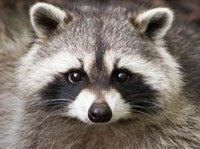Tobi McIntyre

Common in many North American cities, the raccoon will eat practically any type of food — plant or animal. Many people see the raccoon’s distinctive facial fur colouring as looking like a burglar’s mask, which fits with the common perception of raccoons as pests. Highly social and intelligent animals, raccoons inhabit every Canadian province except the island of Newfoundland.
Raccoon Fact File
Scientific name: Procyon lotor
Length: About 80 centimetres
Weight: Six to eight kilograms
Appearance: Although its fur can vary from white to black or brown, it is usually a grizzled grey colour. The tail is marked by five to 10 alternating black and brown rings.
Habitat: The highly adaptable raccoon’s only apparent habitat requirements are a source of water and food and a protected area for denning. Home ranges vary greatly between 50 square kilometres in some rural areas to less than one-tenth of a square kilometre in many cities.
Did You Know . . .
- The name raccoon is derived from the Algonquian word arakun, meaning “he scratches with his hand.”
- There are about 1.1 million raccoons in southern Ontario alone.
- Because the animal can spread its front toes widely, it can use its forepaws to handle food and other objects.
- There are six species of raccoon in North, Central and South America as well as on some of the Caribbean islands.
- A family consists of the adult female and her three to seven young. Family members are sociable, hunting for food together during the night and denning together during the day.
- The average lifespan of raccoons in the wild is three to five years.
- Raccoons’ major predator is human. Other predators include pumas, bobcats, coyotes, foxes, dogs, wolves, great horned owls and fishers.
- To create habitat for raccoons, provide denning sites such as hollow trees and logs.
